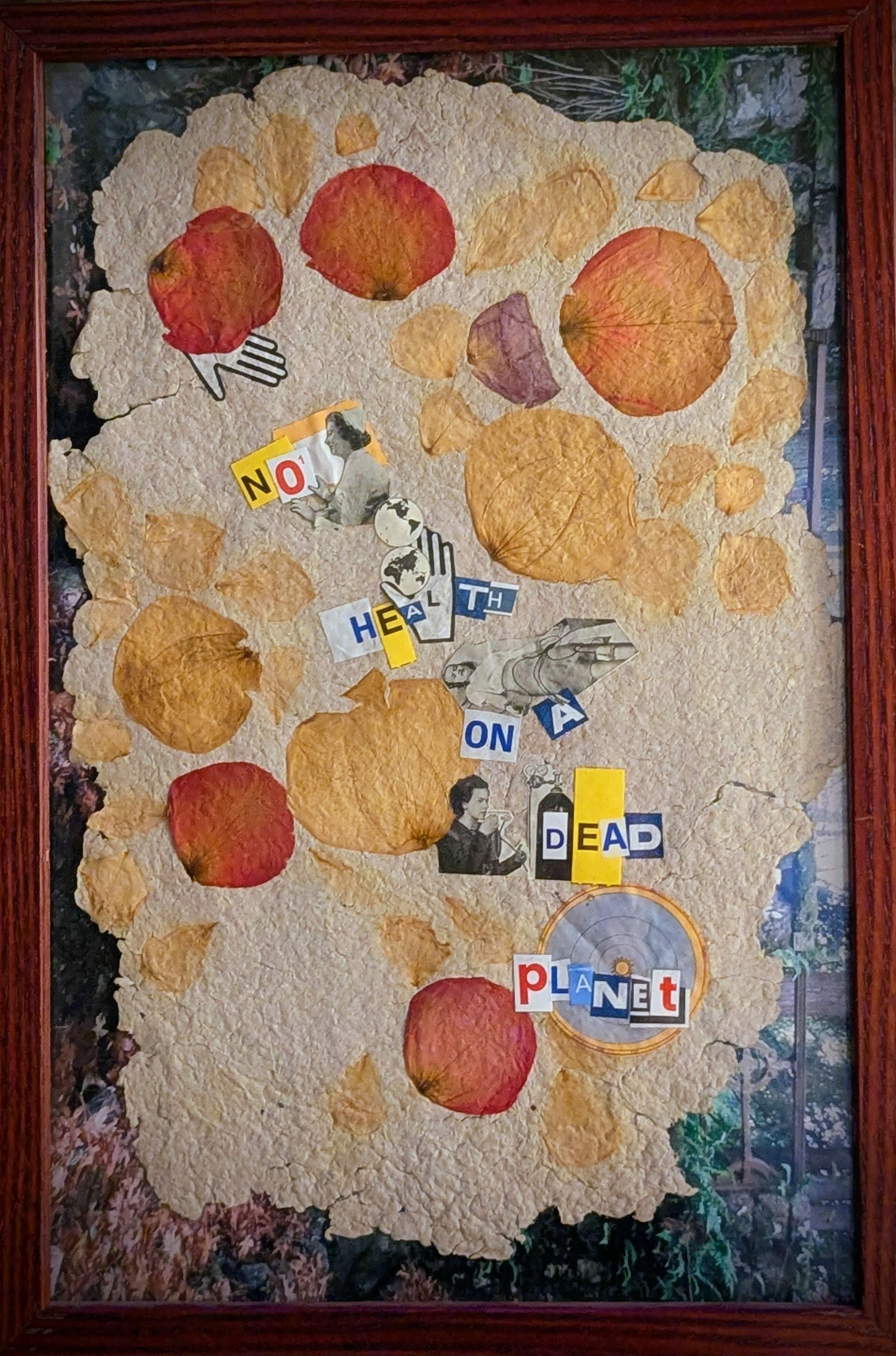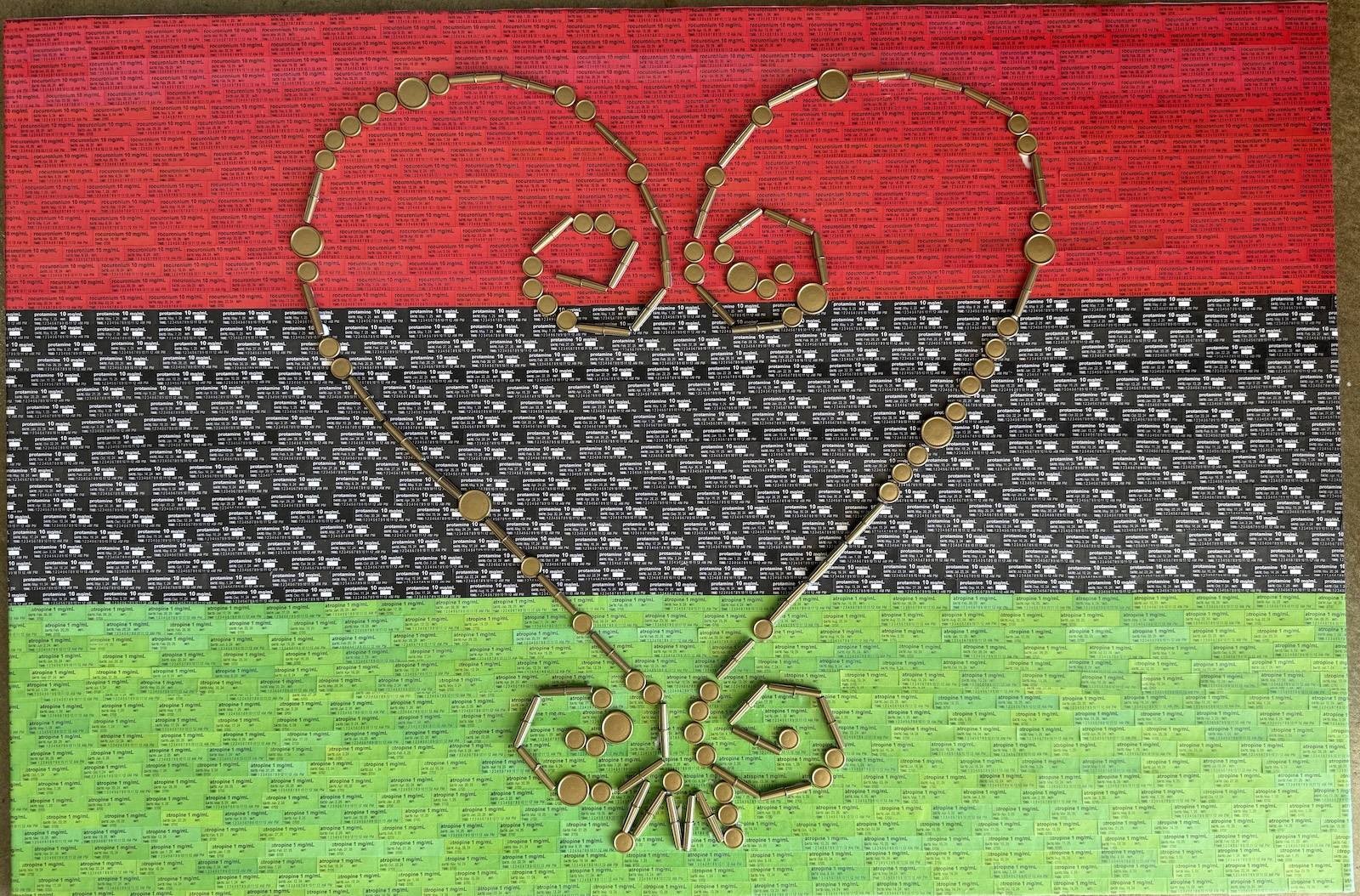The fourth annual waste to art exhibit was held at Millberry Union on May 22, 2025. Over a hundred people stopped by to check out the various art pieces made by members of the UCSF community with recycled materials from the hospital and laboratory setting. The people who stopped by the exhibition were able to vote for their favorite pieces.
If you missed the exhibition, the pieces will be displayed again during the Waste to Art: Pop-Up event at Parnassus’s Moffit Cafe on June 4 from 9:30 a.m. to 1:30 p.m.
Here are this year’s results:
1st place: "Ransom Note from the Planet" by Anita Virmani

This ransom note-style piece considers the Earth's perspective. The piece reads “No health on a dead planet,” making viewers consider the contradiction in the healthcare industry. The consumption, pollution, and production of waste that occur in healthcare are at odds with healthcare’s overarching goal of protecting human life.
The paper used in this work was created by grinding sterilization bags, medical equipment packaging, and other clean & disposable waste into a paste of fibers. The paste was then spread flat on a screen and dried. Pressed flower petals, discarded encyclopedias, and other medical supply waste were then collaged on top of the homemade paper.
As a dental student, the artist has witnessed the accumulation of disposable plastic films, hard plastics, paper, and cardboard at the end of each appointment. Clearing away single-use items and dumping them in teeming bins every day, she wonders “shouldn’t this all be biodegradable by now?”
2nd place: "The Operating Theatre" by doctors and orthopedic surgeons: Angel Xiao, Alicia Asturias, Rosanna Wustrack

In 2017, The New Yorker released a cover by Malika Favre capturing the patient’s perspective moments before surgery. Her depiction of an all-female team resonated with other surgeons across the world. Surgical teams began to replicate the image under the hashtag #ILookLikeASurgeon, bringing visibility to women and other minority groups working in traditionally white, male-dominated fields.
The artists shared the vision for this piece in their art description, which included clips of news articles used to recreate this iconic scene.
“We began by using plaster and cast fiberglass to create a canvas. We then layered on operating room supplies (gloves, blue sheets, autoclave packaging) as well as news clippings from the latest edition of the Journal of Academic Association of Orthopedics (JAAOS), with a special focus on articles regarding diversity, equity, and inclusion. Despite promising strides towards gender representation, in 2019, women still only constituted 15.4 % of orthopedic surgery residents, 19.9% of faculty, and 9 % of program directors. Lastly, we included a central shining light powered by batteries from OR tools that are commonly disposed of after the case. Our piece is an homage to the #ILookLikeASurgeon movement and a nod to the power of a more diverse workforce.
3rd place: "SANKOFA" by Charlene M. Blake, MD, PhD

This piece uses over 1,500 hand-selected and trimmed syringe medication labels as its primary color medium to form the Pan-African flag, designed by Marcus Garvey in 1920, to represent and unite people of African descent. The work reclaims hospital waste, transforming it into a layered reflection on identity, responsibility, and collective
healing.
At the center is a gold spray-painted rendering of the West African Adinkra symbol Sankofa, shaped from discarded rocuronium lids and tubing end caps.
In this piece, they become Morse code: dots made from small vial tops, dashes from combining two tubing caps, and medium vial tops separate words. Moving clockwise from the bottom left swirl, the left half of the heart spells “I am part of the problem,” and the right half, “I am part of the solution.”
The medium choice and layout echo the Sankofa meaning: to look back in order to move forward.
This artwork questions the dual roles we each play in systems we inhabit, especially within medicine, and challenges the viewer to engage with both complicity and possibility. It also honors the unseen labor of hospital staff and the value of materials typically discarded without a second thought.
Blake hopes that viewers will take away a deeper understanding of the impact of the Trans-Atlantic slave trade and be called to take action.
"Reverberations of the Trans-Atlantic slave trade remain present and permeate all aspects of life, especially for those racialized as Black. Through unity, reflection and action, we move towards healing and liberation. In this space and others, how are you ‘part of the problem’? Humble yourself. How are you ‘part of the solution’? Do it," Blake said.
Special thanks to the Anesthesia Technicians at UCSF Parnassus for rescuing and saving the labels that made this project possible.
The three winners were selected from votes from the public and the three special judges: Bernadette Wilks, MD, Anesthesiologist and Visiting Professor in the UCSF Department of Anesthesia, Karina Hammoud, Program Specialist at the Recology San Francisco Environmental Learning Center and Artist in Residence Program, and Dan Henroid, Director of Food and Nutrition Services and Sustainability Officer for UCSF Health.
The Waste to Art program was launched in 2021 by Dr. Seema Gandhi and Sustainability Analyst Kaiyi Wang to raise awareness about the significant volume of medical waste generated by the healthcare industry.
Dr. Gandhi, an anesthesiologist, also serves as the organization’s Medical Director of Sustainability. She frequently collaborates with Wang on a range of initiatives focused on reducing energy use and minimizing waste.
You can learn more about the Waste to Art program by visiting the Office of Sustainability website.